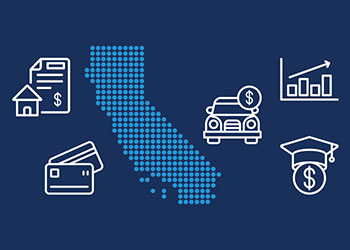- By:
- Category:

Berkeley, CA, July 27, 2023 — New data released today by the nonpartisan California Policy Lab (CPL) shows a sharp downward trend in the number of new mortgages originated in California since late 2020. In the fourth quarter of 2020, 929,500 Californians took on new mortgages, and CPL projects that number fell 90% by the first quarter of 2023, with only 95,000 Californians taking on new mortgages. The new data is from the CPL’s California Credit Dashboard which uses credit bureau data to provide near-real-time measures of the financial health of Californians.
During that same time period (Q4 2020 to Q1 2023), the size of the average mortgage loan in California grew by more than $125,000 – from $468,000 to about $594,000. Due to lags in reporting of mortgages to credit bureaus, the most recent four quarters of originations are projected.
“Far fewer Californians are taking out new mortgages, a trend that started even before the Federal Reserve began increasing interest rates,” explains co-author Evan White, the Executive Director of the California Policy Lab at UC Berkeley. “The loans that are being made are on average much larger, indicating that the remaining market skews wealthier.”
This reshuffling of the mortgage market is evident throughout California, but there are large regional differences in average loan amounts. In the Bay Area, the average new mortgage in the first quarter of 2023 was $731,400, compared to $439,300 in the Greater Sacramento region, and $285,800 in the Northern California region.
CPL also published updated research on Californians’ financial health to the California Consumer Credit Dashboard, including a new chart focused on monthly payments and new map features that allow users to filter the population and compare custom time ranges.
This new version of the Dashboard includes 10 longitudinal charts for 6 types of debt (auto, credit card, home equity, mortgage, student, and other) and collections. The figures can be sorted by 7 age groups, 9 economic regions, and 5 credit ratings. The Dashboard data generally spans from Q1 2004 through Q1 2023.
Additional Findings from Q1 2023
- The state’s overall delinquency rate in Q1 2023 (counting all loan types included in the Dashboard) is 5.0%. That’s a small decrease from the 5.3% delinquency rate in Q4 2022, but much higher than the pandemic low of 2.7% in mid-2021.
- Average monthly payments on all major loan types continued to rise in nominal dollars. The average mortgage payment is now $2,360, up $150 over the same time last year. The average auto payment is $538, up $40 year-over-year.
- The average new auto loan amount fell to $32,900, down from $35,700 last quarter. That’s the first decline since early 2021.
More about the California Credit Dashboard
The Dashboard uses credit-bureau data from the University of California Consumer Credit Panel. All figures in the Dashboard are based on a 2% random sample of individuals. Where applicable, the results are multiplied by 50 to obtain the full-population estimate. A technical appendix provides detailed information about the data and underlying research. Several dozen faculty and graduate students from the University of California currently use this dataset for research.
###
The California Policy Lab translates research insights into government impact. Through hands-on partnerships with government agencies, CPL performs rigorous research across issue silos and builds the data infrastructure necessary to improve programs and policies that millions of Californians rely on every day.
